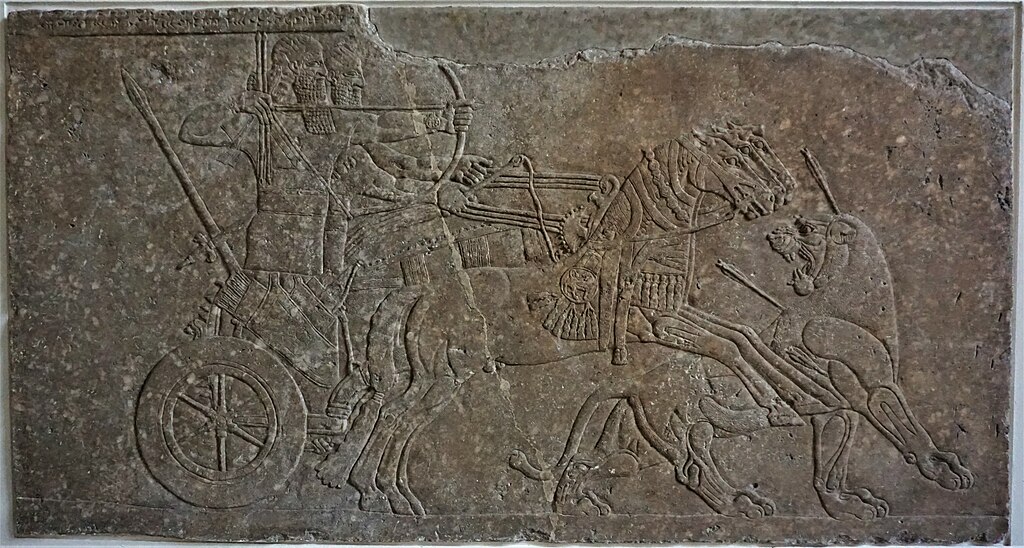
This Lion Hunt Relief came from a wing of Northwest Palace of the Royal Residence of King Ashurbanipal in Nimrud, present-day Iraq.
The relief shows the king, standing on a light hunting chariot, which is guided by a charioteer and pulled three horses. Three arrows have hit the lion.
The King once again aims an arrow at the lion. The lion has turned its head back and seems to roar its attacker in pain.
The royal lion hunt is a symbol of the King overcoming the dangers and challenges to the Assyrian state by its ruler.
Particularly noteworthy is in the initially colored bas-relief of detail, such as in hunting chariots and weapons, as well as in the richly decorated horses with their teeth.
This section of the relief is only the lower part of a three-walled wall relief, the total height of which was about 2.30 m.
While the upper register with another narrative relief is lost, only a few remnants of two lines of cuneiform have been preserved from the middle register, which bore the king’s standard inscription.
An almost identical representation, now in the British Museum in London, shows the bow-shooting king, who has just killed a male lion.
Nimrud has been one of the primary sources of Assyrian sculpture, including the famous palace reliefs.
A series of the distinctive Assyrian shallow reliefs were removed from the palaces, and sections are now found in several museums, in particular, the British Museum and the Pergamon Museums.
These show scenes of hunting, warfare, ritual, and processions.
There are about two dozen sets of scenes of lion hunting in surviving Assyrian palace reliefs.
Neo-Assyrian palaces were very extensively decorated with such reliefs, carved in shallow reliefs on slabs that are mostly of gypsum alabaster, which was plentiful in northern Iraq.
Other animals were also shown being hunted, and the main subject for narrative reliefs was the war campaigns of the king who built the palace. Other reliefs showed the king, his court, and “winged genie” and lamassu protective minor deities.
Nimrud
Nimrud is an ancient Assyrian city located 30 kilometers (20 mi) south of the city of Mosul, in the Nineveh plains in Upper Mesopotamia.
It was a major Assyrian city between about 1350 BC and 610 BC. The city is located in strategic position north of the point that the river Tigris meets its tributary, the Great Zab.
In the mid 19th century, biblical archaeologists proposed the Biblical name of Kalhu (Calah), based on a description in Genesis 10.
The city gained fame when king Ashurnasirpal II (883–859 BC) of the Neo-Assyrian Empire (911–605 BC) made it his capital at the expense of Assur.
He built a large palace and temples in the city, which fell into disrepair during the Bronze Age Collapse of the mid-11th to mid-10th centuries BC.
Archaeological excavations at the site began in 1845, and many vital artifacts were discovered, with most being moved to museums in Iraq and abroad.
Historical artifacts from Nimrud can now be found in over 76 museums worldwide, including 36 in the United States and 13 in the United Kingdom.
In 2015, the terrorist organization, the Islāmic State of Iraq and the Levant (ISIL), destroyed much of the site. The excavated remains were damaged because of its Assyrian history.
Lion Hunt Relief from Nimrud
- Name: Lion Hunt Relief from Nimrud
- Date: 883-859 BC
- Location: Nimrud, modern Kalchu
- Type: Relief Sculpture
- Culture: New Assyrian
- Material: Stone Alabaster
- Dimensions: Height: 97 cm; Width: 183 cm
- Museum: Pergamon Museum
Explore the Pergamon Museum
- The Pergamon Altar
- Ishtar Gate
- The Market Gate of Miletus
- Tile – Building Ceramic – Iran 13th – 14th Century
- Lion Hunting Scene – 750 BC
- Islamic Astrolabe
- Islamic Prayer Niche
- Victory Stele of Esarhaddon
- Desert Place of Mshatta Facade
- Temple of Ashur Water Basin
- Orpheus Mosaic from Miletus
- Lion Hunt Relief from Nimrud
- Ottoman Small Pattern Holbein Knotted Carpet – 16th Century
- Masterpieces of The Pergamon Museum
The rise and fall of the Assyrian Empire
Who were the Assyrians? History of the Assyrian Empire
~~~
“That men do not learn very much from the lessons of history
is the most important of all the lessons that history has to teach.”
– Aldous Huxley
~~~
Photo Credit: 1) JOM Sources: Museum material and Wikipedia.
Popular this Week








 Sponsor your Favorite Page
Sponsor your Favorite Page SEARCH Search for: Search Follow UsJoin – The JOM Membership Program
Sponsor a Masterpiece with YOUR NAME CHOICE for $5
Share this:
- Tweet
